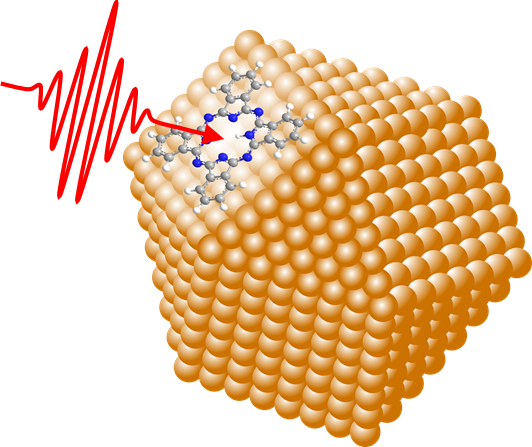The ability to analyze binding configurations in isolated nanosystems is of tremendous interest because how molecules attach to a surface is crucial in chemical processes. Dr. Lukas Bruder and Prof. Dr. Frank Stienkemeier from the University of Freiburg have succeeded in researching the binding configurations and mobility of organic molecules on ultracold noble gas particles.
 Laser excitation of a phthalocyanine molecule on the surface of a noble gas cluster consisting of a few hundred neon atoms. The system has a size of less than ten nanometer. Image Credit: Research Group, University of Freiburg
Laser excitation of a phthalocyanine molecule on the surface of a noble gas cluster consisting of a few hundred neon atoms. The system has a size of less than ten nanometer. Image Credit: Research Group, University of Freiburg
They learned about the many binding configurations between molecules and the nanoparticle surface, as well as how these configurations change following exposure to light.
Phosphocyanine molecules were investigated as key building blocks for optoelectronic and organic photovoltaic applications in this regard. The findings were reported in the journal Nature Communications.
Particularly High Time and Energy Resolution
Single molecules were placed on isolated noble gas particles in an ultrahigh vacuum for the experiments, which were then analyzed using coherent two-dimensional spectroscopy. When used on isolated nanosystems, this approach enables the investigation of molecular characteristics with extremely high temporal and energy precision.
The temporal resolution is a fraction of a millionth of a second, allowing real-time monitoring of binding processes.
What is particularly surprising is the large number of possible binding configurations that we were able to estimate.
Ulrich Bangert, PhD Student, Institute of Physics, University of Freiburg
Bangert oversaw the majority of the laboratory work. The finding, which was made feasible for the first time by identifying the homogenous line profile in such a system, provides fresh motivation for the theoretical modeling of nanoparticles.
Promising Approach for Further Research
It will be interesting to see how our research method can be transferred to other nanoparticles, such as catalytic nanoparticles.
Dr. Lukas Bruder, Academic Councilor (tenured), Institute of Physics, University of Freiburg
However, the high resolution achieved also shows in general a promising perspective for investigating photochemical reactions in nanosystems.
Dr. Frank Stienkemeier, Professor, Experimental Physics, University of Freiburg
Journal Reference:
Bangert, U., et al. (2022) High-resolution two-dimensional electronic spectroscopy reveals the homogeneous line profile of chromophores solvated in nanoclusters. Nature Communications. doi:10.1038/s41467-022-31021-z.